Warmth on the Frozen Ladakh Plateau
5 Comments
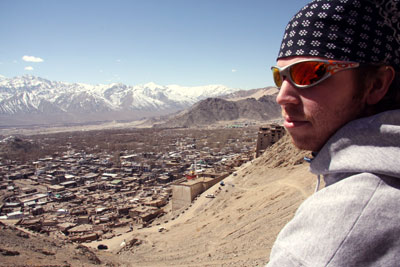
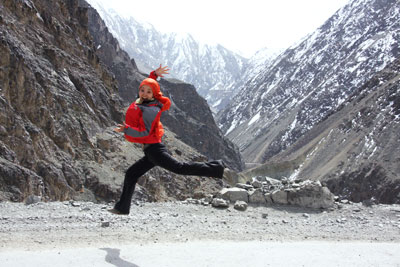
After the high intensity action and sleepless nights in Delhi, Tina and I both took a breath of fresh air when we arrived in Ladakh. The air-born pollution in Delhi is as suffocating as opening your window in Beijing, and the calm mountain air was exactly what the doctor ordered. Unfortunately, we hadn’t anticipated poisoning ourselves.
Ladakh is a secluded valley nestled between two mountain ranges in the Kashmiri region, at the very north tip of India, not far from the Chinese border. The valley is so secluded that historians claim the form of Buddhism practiced here precedes that of Tibet and the rest of Asia. Otherwise, culture and life is similar to a modern (and free!) Tibet. Ladakh was the first area of India we encountered that wasn’t overcrowded. The population growth is a steady twenty five people a year. The respect given to monks and nuns, as well as societal and environmental values, keep Ladakh’s native population to a very small town feel. Locals are so compassionate that we hitch hiked twice during our stay, a practice that is as common as taking the bus. In the summer, the valley gets flooded with tourists who come in search of nature, majesty and peace. The economy in Leh is the tourism industry, meaning that business is good for four months of the year, and goes into hibernation the other eight months. The Indian army maintains a significant presence all through Ladakh, as it is the closest safe zone to the war-torn area of Kashmir. There is little evidence of Indians integrating themselves into society there, they mostly hide in their heated shacks behind barbed wire along the one major road. Kashmir has been relatively safe for some time, and army’s only remaining purpose is keep the snow covered highway clear.
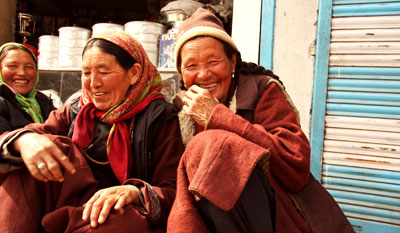
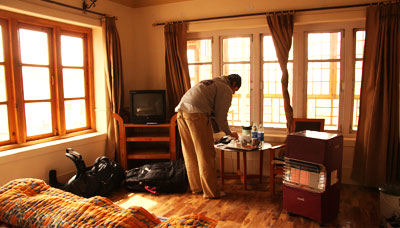
Top: street vegetable sellers laughing.
Bottom: our hotel room with mountain facing windows. Leh, India.
Life ranges in altitude from three to six thousand meters above sea level, which means elevation sickness is guaranteed. The first step off the plane was a great contrast from muggy thick air of Delhi. I instantly felt healthy and full of energy again. We were weary of trusting anyone at the airport, but Tina found them to be so warm and helpful that she couldn’t resist chatting with them, while trying to get the phone line to work. We hired a driver for a very reasonable non-negotiable price, and went to check out a couple of hotels. Within a half hour, we had found the hotel we liked the most, Omasila (1800 rupees/night, ~ $45). The owner was quick to point out that Brad Pitt had stayed in the room above ours, last year. He had the pictures and movie posters to prove it. Nawang had a beautiful place, entirely wood lodges with big beds, satellite tv and a spectacular view of the Zanskar mountain range that lights itself in the morning. Not a single hotel had running water, as all the pipes were frozen, but most had propane heaters and staff that would bring hot water on request. We were very lucky to be staffed by the very humble Rigzen, who is usually an expedition driver but works with Nawang during the off season. Rigzen brought us everything from food to water, drove us all over the valley, and ensured that we were well taken care of.
Our first couple of days completely blindsided both Tina and I. I felt like my neck was restricting itself, giving me a headache and draining every ounce of energy my muscles had. I slept most of the first two days, while Tina read and slept. On the third day, we wanted to escape our escalating cabin fever and explore the area. We mounted a japanese-built buddhist stupa, high above the village. It took Tina and I more than an hour to complete the steep hundred stair climb, as locals breezed by us. It was painfully slow, but well worth it. The view from the top was the first mind-centering wow moment I experienced in India. We happened to meet a photography professor who became a good friend as we talked on the slow descent to lower paradise. Exhausted from the exercise, we slept well that night, especially after removing the leaky propane heater that was poisoning us while we slept.
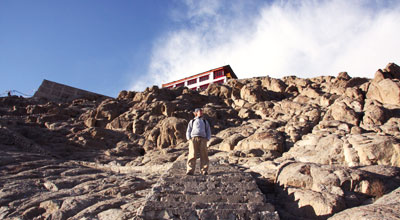
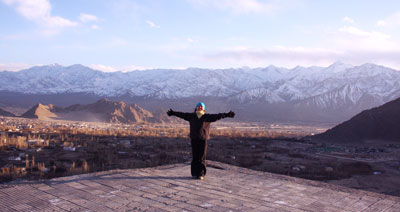
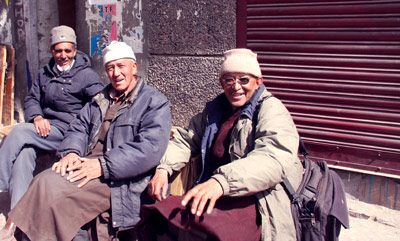
Top: Adam, on our climb to the Japanese Gompa.
Middle: Tina, above the village of Leh, beside the Japanese Gompa
Bottom: Middle aged men chilling on the street side. Leh, India.
We spent the next two days exploring and enjoying the village life in Leh. We made an exhaustive, but memorable climb to the highest gompa in the Leh valley. We haggled with the merchants in the market, and got denied every time (turns out they’re honest in Leh and do not charge a foreigner’s price). We ate traditional Ladakhi and Tibetan meals in the most popular restaurant in town. We consumed bags full of prized Ladakh dried apricots like they we our only source of digestive nutrients.
On our fifth day in Ladakh, we witnessed firsthand what compassion means to the Tibetan people. To give some background, during our stay in Leh, there had been an uprising in Tibet. The Tibetan people were rioting against Chinese control by vandalizing Chinese businesses. The Chinese were fighting back by sending the army in to calm to situation. There were many reports of citizen and monks being killed and injured in three of Tibet’s major cities. Although we were safe in India, we were physically quite close to the Tibetan border, and many of the local people were Tibetan immigrants or descendants. As a display of spirit and compassion, the town of Leh organized an evening parade through the streets leading to the gompa in the center of town. All the townspeople carried a single candle, most with homemade wind shelters, as they marched chanting Tibetan prayers. As we felt the songs of prayers, tears came to our eyes. Upon reaching the overcrowded gompa courtyard, the town huddled together for warmth and the lamas offered prayers, then united them in song. An unforgettably heartwarming experience.
On our second last day in Ladakh, we hired Rigzen to drive us out to Lamayuru and Rizong monasteries. Lamayuru in about two hundred kilometers from town on the most nerve-popping, ball-busting, don’t-look-down-or-straight-ahead drive I’ve ever been on. Blasting down the one-lane mountain-snaking road through the Ladakhi plateau, Rigzen played the steering wheel and stick of his Mahindra SUV like a world famous cellist. Once I was able to relax and trust the traction of the car and reaction speed of the driver, I got rewarded with the most spectacular views I have ever witnessed. Mountains that touch the sky, and endless deep canyons filled every view. And, there was not a single sign of life in sight for miles and miles.
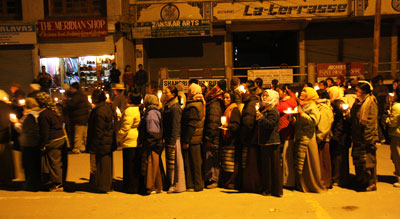
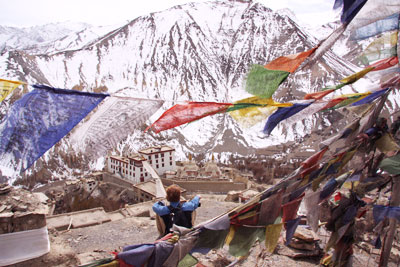
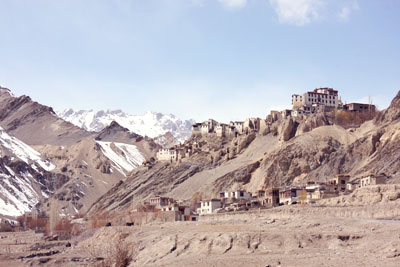
Top: Tibetan parade praying for Tibetans in China after Chinese lock down.
Middle: Overlooking Lamayuru’s gompa on ledge to stupa.
Bottom: Lamayuru Monastery from a distance along the highway.
Lamayuru is a special place. Set high atop a mountain and surrounded by peaks, the iconic monastery is peaceful and soul warming. I witnessed my first Tibetan Buddhist monk reciting scriptures with a gong-like drum, and was instantly mesmerized. I wanted to just sit for hours and chant with him. After exploring all the stairs, mud passageways and locked doors, we shuffled up a rock ledge to the stupa overlooking the gompa. Peering down kilometers in the gorge and out over snow-capped peaks disappearing into fleeting clouds, I felt my true physical insignificance on earth. Really puts your life into perspective, and makes you introspective.
We spun back down the mountains and recovered from our dizzying spell in a canyon facing a white-walled, red-roofed Rizong monastery that stood up like a wall in front of us. The feature of is its school where 50 young monks and nuns are given a western education to offset their buddhist studies. As we slid up the hill, Tina pointed to small heads peering out over the roofs and balconies examining the foreigners invading their peaceful fortress. Once we reached the main level, we were graciously welcomed by an older monk who was having trouble speaking through his missing teeth. Before long, the curious younger monks came to see who their friend, Rigzen, had brought this time. We later found out that Rigzen was born and raised in the small village where we entered the canyon, and as a driver, had become a local celebrity.
We followed them up the narrow rock-cut stairs as they showed off their colorful prayer rooms, filled with old world charm. Without question, we left them a donation of a few hundred rupees in a donation box that had clearly never been emptied.
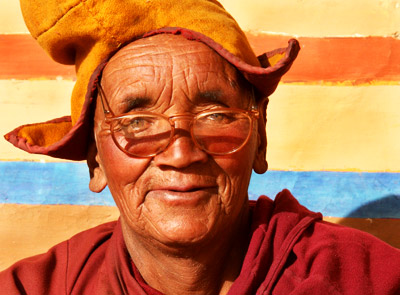
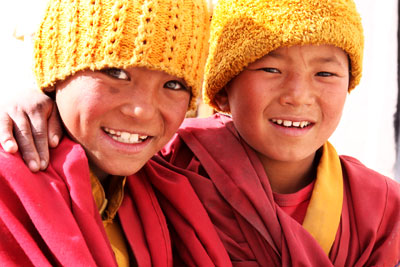
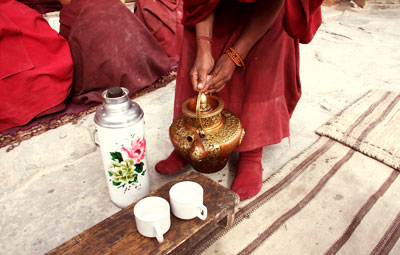
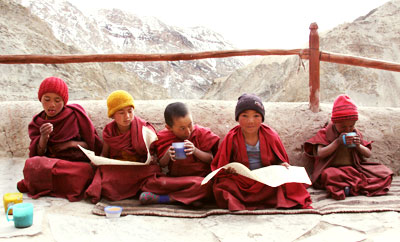
Top: A smiling Lama at Rizong Monastery.
Middle 1: Small monks greeting us at Rizong Monastery.
Middle 2: We were welcomed with both sweet milk tea and Tibetan butter tea.
Bottom: Monks on the patio taking a tea break during their scripture studies.
We were then led to the main patio where all the monks in the monastery were memorizing scriptures out loud, while partaking in milk and yak-butter tea with plain flatbread. Without anything to chant myself, Tina and I sat and soaked in the zen-like atmosphere while we were so graciously served by our maroon-clad hosts. I knew I was blessed to experience such an amazingly warm gathering in the middle of such secluded mountainous landscape. I took off one of my jackets. Tina took pictures of the monks and was then surrounded in a sea of maroon capes when she showed their smiling faces. We spoke with the director of the gompa and offered to return as volunteer teachers.
On the drive back to the hotel, I felt that the last couple of days had been worth all the trials and tribulations of our India trip up until now. Little did I know what was coming the next morning.
After a very nourishing breakfast of corn flakes and boiled eggs, Rigzen brought us to the grand Thikse gompa, just thirty minutes south of Leh. When we arrived, we were surprised to find the paths between the mud-brick buildings almost devoid of life. We had been promised that the busiest gompa in the winter months was Thikse, and we were sure to meet quite a contingent of monks. We wandered around for an hour before hearing a Tibetan horn echoing from the main courtyard. We rushed to look, and found a parade of colorful dresses flowing down the concrete path towards the main entrance. The horns and drums were loaded into the back of a truck while they continued their symphony. We begged Rigzen to follow them down into town, where they unloaded into a stone-walled courtyard encompassing a common building with traditional Ladakhi temple doors.
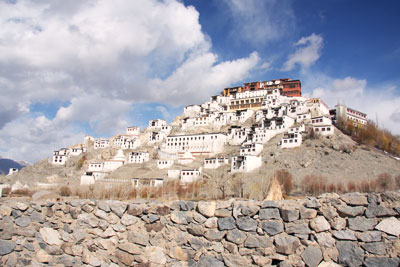
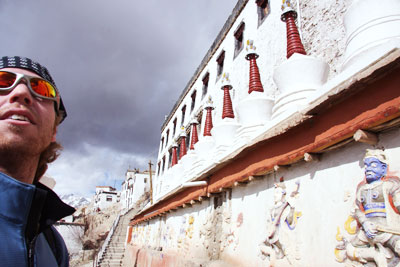
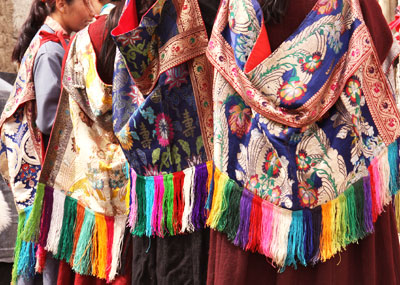
Top: Thikse Monastery set along the sides of a mountain 15Km south of Leh.
Middle: Adam at Thikse Monastery.
Bottom: The backs of village women near Thikse.
We followed the crowd shyly and tried our best to fit in, but we stuck out like a sore thumb. Everyone took a double look at us, as we tried to blend in by sitting in a corner on a tree log. Sighs of relief puffed out of us, as we saw some smiling faces greeting us from a distance. One of the organizing women invited us into their outdoor exhibition hall, where all the ladies of the village were sitting and enjoying tea and thukpa (Tibetan noodle soup). We started a conversation with three girls who looked around our age, and found out that this was the opening of the women’s center and temple. They promised that tomorrow would be a fantastic festival of song and dance that villagers from near and far come to partake in. Tina snapped the shutters of her camera in front of everyone in the hall, while they passed hats and flowers, and begged her to take more.
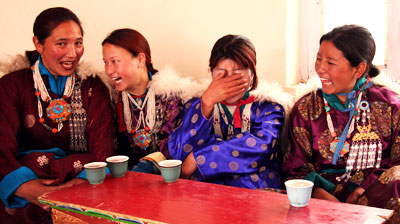
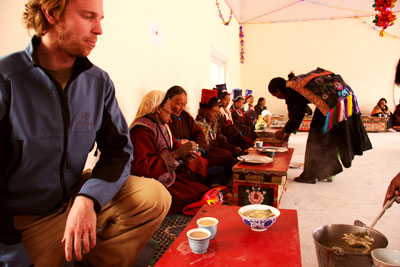
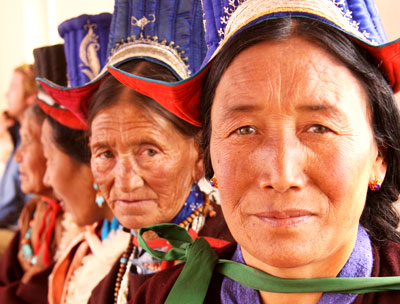
Top: Girls at the village opening ceremony. Tina knew how to make them laugh.
Middle: Adam being served thukpa.
Bottom: Faces of local women. They took turns getting photos taken by Tina.
We wished we could stay longer, but had planned for this day to be our last in Ladakh, and our plane ticket was already set. When we got back to town, we did some internet searching and made some phone calls, but weren’t able to change tickets until we got to the airport the next morning. After some fast talking and three thousand rupees (~$75), we changed our flights for an extra day of culture assimilation in Leh. We did make it to the ceremony and it really was fantastic, but the sights and sounds are best described in Tina’s descriptive photographs and my short videos.
We left a day later than planned, but I knew on the plane that I was losing much more than time.
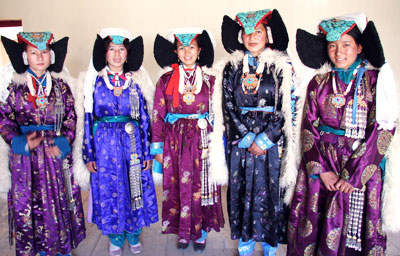
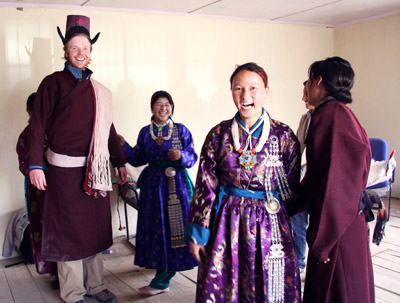
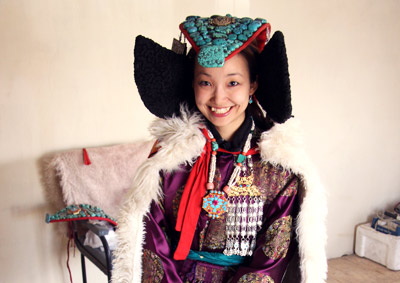
Top: The girls in traditional costumes for special occasions.
Middle: Good laughs as the girls dressed Adam in Mongolian gowns.
Bottom: Tina dressed in traditional Ladakhie costume at the ceremony.
- Browse in Timeline:
- « Taj Mahal
- » The Spirit of Varanasi


















Carole Fogarty
May 06 08, 3:35 pm
Mariela De Marchi
May 09 08, 5:10 am
Chris Sharp
May 19 08, 5:09 am
Linnet Woods
Jun 09 08, 5:20 am
yountan
Mar 05 09, 7:52 am